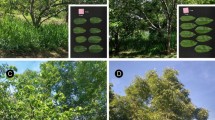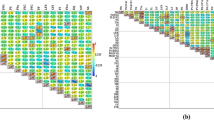Abstract
Waratahs (Telopea spp.) are cultivated for their blooms for the international cut flower market. A morphometric study was conducted on a range of cultivated waratah varieties to determine the variability of selected characters of horticultural importance and which parents might be of value in future breeding programs. Univariate analysis of characters of 13 cultivars revealed the greatest range of variation in number of flowers, bract dimensions, flower colour and leaf margin type. Differences were observed between number of flowers per inflorescence in the T. speciosissima (Sm.) R.Br. group of accessions and the other species cultivars; interspecific cultivars with T. mongaensis, Cheel and T. oreades F. Muell. were intermediate, with a similar pattern observed in bract length and width. Multivariate analysis (canonical variate analysis – CVA) discriminated between waratah cultivars on the basis of flower colour (first axis), then flower number, bract length, leaf width and leaf margin type (axis 2). The third axis also separated leaf width, the fourth leaf length and width, and the fifth leaf apex shape, CVA was also used to explore the genetic contribution of three parent T. speciosissima cultivars to hybrid populations. Hybrids with ‘Sunflare’, ‘Sunburst’ or ‘Wirrimbirra White’ as one parent were very dispersed indicating the range of inheritance of the observed phenotypic characters, leading to the possibility of selecting individuals with the required degree of character inheritance. It was demonstrated that the Telopea speciosissima type, which forms the basis of the waratah cut flower industry, may be improved by hybridising with other Telopea species. The application of the results to the development of waratah breeding programs is discussed.
Similar content being viewed by others
References
Australian National Botanic Garden 2004. http://www.anbg.au/ telopea (last accessed December 2004).
C.P. Baril, D. Verhaegen, Ph. Vigeron, J.M. Bouvet and A. Kremer, Structure of the specific combining ability between two species of Eucalyptus. I. RAPD data. Theor. Appl. Genet. 94 (1997) 796-803
J.G. Cruz-Castillo, S. Ganeshanandam, B.R. MacKay, G.S. Lawes, C.R.O. Lawoko and D.J. Woolley, Applications of canonical discriminant analysis in horticultural research. HortScience 29 (1994) 1115-1119
Gollnow B., Worrall R. and Ireland G. 1995. Development of Australian East Coast Species for Floriculture in Both Domestic and Export Markets. NSW Agriculture.
L.A.S. Johnson and B.G. Briggs, The evolution and classification of a southern family. Bot. J. Linn. Soc. 70 (1975) 83-182
K.H. Krahl and W.M. Randle, Genetics of floral longevity in petunia. HortScience 43 (1999) 339-340
J.M. Martin, L.E. Talbert, S.P. Lanning and N.K Blake, Hybrid performance in wheat as related to parental diversity. Crop Sci. 35 (1995) 104-108
J. Maze, S. Banerjee, Y.A. El-Kassaby and L.R. Bohm, A quantitative genetic analysis of morphological integration in Douglas fir. Int. J. Plant Sci. 153 (1992) 333-340
P. Nixon, The Waratah. Sydney: Kangaroo Press (1997).
C.A. Offord, Telopea (waratahs), family Proteaceae. In: K.A. Johnson and M. Burchett (eds.) Native Australian Plants – Horticulture and Uses. Sydney: NSW University Press (1996) pp. 68-81
C.A. Offord, Waratahs: Horticultural Improvement through Breeding. Plant Breeding Institute: University of Sydney (2001).
C.A. Offord, An examination of the reproductive biology of Telopea speciosissima (Proteaceae) with emphasis on the role of protandry and self-pollination in fruit set. Int. J. Plant Sci. 165 (2004) 73-83
C.A. Offord and L.C. Campbell, The waratah: taming of an emblem. Aust. Hortic. 92 (1994) 52-57
E.C. Olson and R.C. Miller, Morphological Integration. Chicago: University of Chicago Press (1958).
J.M. Ortiz, J.P. Martin, J. Borrego, J. Chavez, L. Rodriguez, G. Munoz and F. Cabello, Molecular and morphological characterisation of a Vitis gene bank for the establishment of a base collection. Genet. Resour. Crop Evol. 51 (2004) 403-409
M.R. Pooler and R. Scorza, Aberrant transmission of RAPD markers in haploids, doubled haploids and F1 hybrids of peach: observations and speculation on causes. Scientia Horticulturae 64 (1995) 233-241
C. Venkata Rao, Proteaceae. Botanical Monographs 6. New Delhi: CSIR (1971).
H.C. Wernett, T.J. Sheehan, G.J. Wilfret, F.J. Marousky, P.M. Lyrene and D.A. Knauft, Postharvest longevity of cut-flower Gerbera. I. Response to selection for vase life components. J. Am. Soc. Hortic. Sci. 12 (1996a) 216-221
H.C. Wernett, G.J. Wilfret, T.J. Sheehan, P.M. Lyrene, F.G. Martin, T.L. White, G.L. Powell and C.J. Wilcox, Postharvest longevity of cut-flower Gerbera. II. Heritability of vase life. J. Am. Soc. Hortic. Sci. 12 (1996b) 222-224
Author information
Authors and Affiliations
Corresponding author
Rights and permissions
About this article
Cite this article
Offord, C.A. Analysis of Characters and Germplasm of Significance to Improvement of Australian Native Waratahs (Telopea spp., family Proteaceae) for Cut Flower Production. Genet Resour Crop Evol 53, 1263–1272 (2006). https://doi.org/10.1007/s10722-005-3487-7
Received:
Accepted:
Published:
Issue Date:
DOI: https://doi.org/10.1007/s10722-005-3487-7




